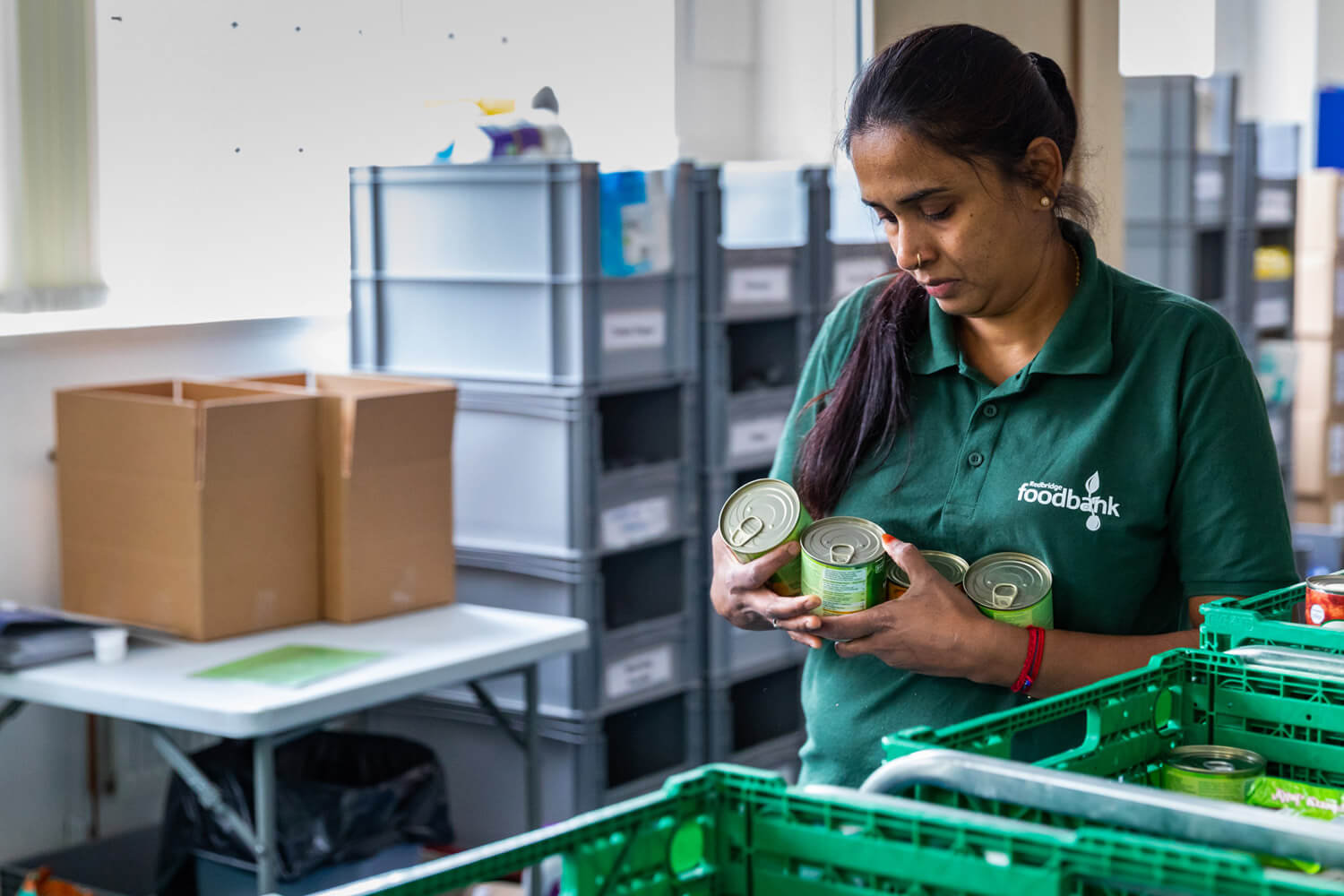End of Year Stats
More than 3.1 million emergency food parcels were distributed by food banks in the Trussell Trust network in the past 12 months — the most parcels ever distributed by the network in a year and nearly double the number compared to five years ago.
Food banks in the Trussell Trust network saw the highest ever levels of need as more people found their incomes did not cover the cost of essentials like heating and food. Between April 2023 and March 2024, the number of people that used a food bank for the first time was 655,000.


3.1 million
emergency food parcels

94%
increase over the past five years

1.1 million
emergency food parcels provided for children
Between 1 April 2023 and 31 March 2024, food banks in the Trussell Trust’s UK-wide network distributed more than 3.1 million emergency food parcels to people facing hardship – this is an increase of 94% over the past five years. More than 1.1 million of these parcels were distributed for children.


Our general election manifesto
We cannot allow these rising levels of need to continue, and we know what needs to change to help people who can’t afford the essentials.
This is an issue the next government cannot ignore and that is why, ahead of the UK general election, we’re setting out our manifesto to end the need for food banks.
“It’s 2024 and we’re facing historically high levels of food bank need. As a society, we cannot allow this to continue. We must not let food banks become the new norm. As we approach the next UK general election, we urgently need all political leaders to set out how they will build a future where no one needs a food bank to survive. Voters want to see a change and we need cross-government action at all levels to deliver it. We know what’s pushing people to food banks, so we know what needs to change.
A supportive social security system is the bedrock on which we end hunger for good. Building on this, we need much more effective employment and financial support for parents, carers and disabled people, and action to ensure everyone can have the security we all need to access opportunities and have hope for the future, through more secure and flexible jobs and investment in social housing.
Food banks are not the answer. They will be there to support people as long as they are needed, but our political leaders must take bold action to build a future where everyone has enough money to afford the life’s essentials. The time to act is now.”

Emma Revie
Chief Executive
Factsheets
Read our factsheets for a detailed breakdown of what this year’s statistics are telling us at a UK level and the findings for Northern Ireland, Scotland, and Wales.
Food bank Statistics for previous Financial Years with Regional Breakdown
| TOTAL | 2017/18 | 2018/19 | 2019/20 | 2020/21 | 2021/22 | 2022/23 | 2023/24 |
| United Kingdom | 1,354,682 | 1,606,810 | 1,909,360 | 2,578,919 | 2,183,061 | 2,997,589 | 3,121,404 |
| England | 1,047,118 | 1,236,172 | 1,489,531 | 2,128,143 | 1,789,130 | 2,467,364 | 2,581,092 |
| Scotland | 173,511 | 217,052 | 238,584 | 224,623 | 199,743 | 262,827 | 262,479 |
| Wales | 100,360 | 116,325 | 136,106 | 146,712 | 131,553 | 185,663 | 187,458 |
| Northern Ireland | 33,693 | 37,261 | 45,139 | 79,441 | 62,635 | 81,735 | 90,375 |
| East Midlands | 67,073 | 78,229 | 101,789 | 138,763 | 128,697 | 173,622 | 166,474 |
| East of England | 127,022 | 152,675 | 190,144 | 245,307 | 224,369 | 324,597 | 349,935 |
| London | 137,248 | 167,723 | 204,355 | 423,214 | 284,604 | 388,330 | 454,750 |
| North East | 65,218 | 89,479 | 98,520 | 124,492 | 100,329 | 154,729 | 150,560 |
| North West | 198,818 | 225,198 | 254,220 | 313,754 | 253,006 | 348,727 | 355,830 |
| South East | 128,485 | 155,697 | 199,519 | 305,151 | 259,259 | 349,587 | 347,287 |
| South West | 122,371 | 133,983 | 163,247 | 202,329 | 174,891 | 248,926 | 254,974 |
| West Midlands | 121,384 | 142,942 | 169,142 | 226,492 | 207,819 | 278,189 | 269,743 |
| Yorkshire and The Humber | 79,499 | 90,246 | 108,595 | 148,641 | 156,156 | 200,657 | 231,539 |
| ADULTS | 2017/18 | 2018/19 | 2019/20 | 2020/21 | 2021/22 | 2022/23 | 2023/24 |
| United Kingdom | 862,760 | 1,021,091 | 1,185,211 | 1,583,227 | 1,347,397 | 1,853,954 | 1,977,308 |
| England | 661,018 | 779,103 | 917,170 | 1,296,290 | 1,099,936 | 1,517,974 | 1,630,187 |
| Scotland | 117,534 | 145,604 | 157,529 | 146,618 | 128,739 | 174,018 | 176,466 |
| Wales | 64,339 | 74,480 | 84,352 | 92,186 | 82,931 | 115,862 | 118,864 |
| Northern Ireland | 19,869 | 21,904 | 26,160 | 48,133 | 35,791 | 46,100 | 51,791 |
| East Midlands | 42,435 | 48,956 | 62,503 | 84,695 | 81,663 | 108,138 | 105,240 |
| East of England | 78,713 | 93,667 | 113,857 | 142,972 | 132,077 | 193,041 | 214,897 |
| London | 88,534 | 107,534 | 129,410 | 263,609 | 178,079 | 241,306 | 292,332 |
| North East | 41,400 | 56,202 | 62,037 | 78,336 | 63,347 | 95,663 | 98,023 |
| North West | 123,572 | 141,217 | 153,834 | 192,981 | 155,329 | 214,143 | 224,003 |
| South East | 80,447 | 98,124 | 120,729 | 182,021 | 156,200 | 211,671 | 212,310 |
| South West | 77,105 | 84,197 | 100,399 | 122,631 | 107,438 | 154,202 | 162,670 |
| West Midlands | 77,609 | 91,696 | 106,887 | 138,123 | 130,525 | 174,324 | 173,540 |
| Yorkshire and The Humber | 51,203 | 57,510 | 67,514 | 90,922 | 95,278 | 125,486 | 147,172 |
| CHILDREN | 2017/18 | 2018/19 | 2019/20 | 2020/21 | 2021/22 | 2022/23 | 2023/24 |
| United Kingdom | 491,922 | 585,719 | 724,149 | 995,692 | 835,664 | 1,143,635 | 1,144,096 |
| England | 386,100 | 457,069 | 572,361 | 831,853 | 689,194 | 949,390 | 950,905 |
| Scotland | 55,977 | 71,448 | 81,055 | 78,005 | 71,004 | 88,809 | 86,013 |
| Wales | 36,021 | 41,845 | 51,754 | 54,526 | 48,622 | 69,801 | 68,594 |
| Northern Ireland | 13,824 | 15,357 | 18,979 | 31,308 | 26,844 | 35,635 | 38,584 |
| East Midlands | 24,638 | 29,273 | 39,286 | 54,068 | 47,034 | 65,484 | 61,234 |
| East of England | 48,309 | 59,008 | 76,287 | 102,335 | 92,292 | 131,556 | 135,038 |
| London | 48,714 | 60,189 | 74,945 | 159,605 | 106,525 | 147,024 | 162,418 |
| North East | 23,818 | 33,277 | 36,483 | 46,156 | 36,982 | 59,066 | 52,537 |
| North West | 75,246 | 83,981 | 100,386 | 120,773 | 97,677 | 134,584 | 131,827 |
| South East | 48,038 | 57,573 | 78,790 | 123,130 | 103,059 | 137,916 | 134,977 |
| South West | 45,266 | 49,786 | 62,848 | 79,698 | 67,453 | 94,724 | 92,304 |
| West Midlands | 43,775 | 51,246 | 62,255 | 88,369 | 77,294 | 103,865 | 96,203 |
| Yorkshire and The Humber | 28,296 | 32,736 | 41,081 | 57,719 | 60,878 | 75,171 | 84,367 |
What do these stats show?
Every year we release statistics about the number of emergency food parcels food banks in our network have provided to people. We release figures for the first six months of the financial year in November, and for the full financial year at the end of April or early May. These figures cover 1 April 2023 to 31 March 2024.
Our statistics are a measure of volume rather than unique users. The data is collected using an online system into which food banks enter data from each food bank voucher, and the number of emergency food supplies is recorded.
For example, if a family of three were referred to a food bank twice in one year, this would count as six supplies on the system because it would reflect six instances of a supply going to someone in the household. However, if a family of three were only referred to a food bank once, this would count as three supplies.
Figures from the Trussell Trust cannot be used to fully explain the scale of food bank use across the UK, because our figures relate to food banks in our network and not to the hundreds of independent food aid providers and community groups also providing emergency food, which have increased in number through the pandemic. There are more than 1,400 food bank centres in the Trussell Trust’s UK-wide network. The Independent Food Aid Network has identified at least 1,172 independent food banks, while there are also Salvation Army food banks as well as food banks run from schools and hospitals. There are also thousands of food of other food aid providers including soup kitchens and social supermarkets.
You can read more about our methodology here.
To find out more about the drivers of hunger and who is most at risk, read our research on Hunger in the UK.



